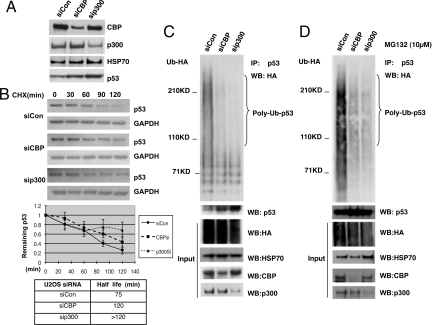Fig. 1.
CBP and p300 regulate p53 stability and polyubiquitination. (A and B) p53 abundance and stability in U2OS cells after CBP or p300 siRNA treatment. (A) U2OS cells transiently transfected with the indicated siRNAs for 72 h were harvested for immunoblotting with anti-CBP, -p300, -hsp70 (loading control), and -p53 antibodies. (B) (Top) U2OS cells transfected with the indicated siRNAs for 72 h were treated with cycloheximide, and lysates were harvested at the indicated times for analysis by p53 immunoblot. (Bottom) p53 levels were quantitated on a blot scanner (LiCOR), and half-life calculated based on the decay of normalized (to GAPDH loading control) p53 levels to 50% of their original level. Values are an average of three independent experiments. Error bars, ±1 standard deviation (S.D.). (C and D) CBP and p300 both drive p53 polyubiquitination in vivo. U2OS cells were treated with the indicated siRNAs for 48 h and transfected with HA-Ub expression vector 24 h before harvest. MG132 (10 μM) was added for 4 h before harvest as indicated. Cell lysates were IP'd with anti-p53 Ab, followed by anti-HA or anti-p53 immunoblot. PolyUb indicates those p53 species >100 kDa that are larger than the largest MUM species as determined by use of non-chain-forming Ub moieties (14). Input lysates were blotted with the indicated antibodies.

